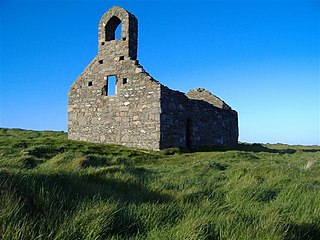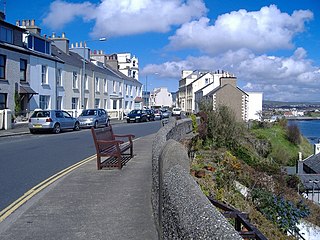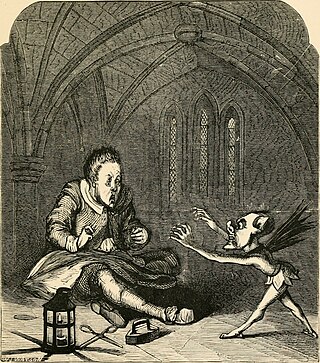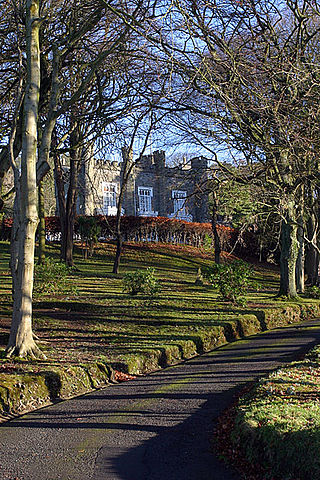
St Michael's Isle, more commonly referred to as Fort Island, is an island in Malew parish in the Isle of Man, noted for its attractive ruins. It covers an area of 5.14 hectares, is about 400 metres long from west to east, and is connected to the Langness Peninsula, near Derbyhaven, by a narrow causeway. The island itself is made of rocky slate and the soil is very acidic. Nevertheless, it has important communities of maritime plants.

Port St Mary is a village district in the south-west of the Isle of Man. The village takes its name from the former Chapel of St Mary which is thought to have overlooked Chapel Bay in the village. Its population is 1,953 according to the 2011 census. In the 19th century it was sometimes called Port-le-Murray.

In Manx folklore, a buggane was a huge ogre-like creature native to the Isle of Man. Some have considered them akin to the Scandinavian troll.
Gerhard Bersu was a German archaeologist who excavated widely across Europe. He was forced into exile from Germany in 1937 due to anti-Semitic laws in pre-war Nazi Germany. He was interned on the Isle of Man during World War II where he made several significant archaeological discoveries such as the Viking boat burial at Balladoole.

Ballabeg is a village on the Isle of Man. It is in the parish of Arbory in the sheading of Rushen, in the south of the island near Castletown. There are several small villages and hamlets with the name, although Ballabeg in Arbory is the most well-known and populous.

Literature in the Manx language is known from the 16th century. Early works were often religious in theme, including translations of the Book of Common Prayer, the Bible and Milton's Paradise Lost. Edward Faragher, who published poems, stories and translations, is considered the last major native writer of the language. The historian A. W. Moore collected traditional Manx-language songs and ballads in publications towards the end of the 19th century.

Andreas is one of the seventeen parishes of the Isle of Man. It is located in the north of the island in the sheading of Ayre. The main settlement in the parish in the village of Andreas, which is also known as Kirk Andreas.

Mount Murray is a hill 222 metres (728 ft) above sea level on the Isle of Man located at the northern end of Santon, near the boundaries with Marown and Braddan parishes. It is named after Lord Henry Murray, 4th Lieutenant Governor of the Isle of Man. Often referred to simply as The Mount and formerly as Cronk Glass(green hill), Mount Murray is home to the Chibbanagh Plantation and nine of the eighteen holes of the Mount Murray Golf Club.

Andreas or Kirk Andreas is a village on the Isle of Man, lying in the north of the island, 5 km from the island's second town, Ramsey. There is a large, and nowadays little used, airfield in the vicinity.
Crosby is a small village located 3+3⁄4 miles west of Douglas in the parish of Marown in the Isle of Man.

Greeba Castle is a castle on the Isle of Man.

Highlander is situated between the 5th and 6th Milestone road-side markers on the Snaefell Mountain Course used for the Isle of Man TT races on the primary A1 Douglas to Peel road in the parish of Marown in the Isle of Man.

There are about eight small places on the Isle of Man with the name Ballabeg. The name Ballabeg derives from the Manx Balley Beg which means small homestead; although the spelling is different, it is pronounced approximately the same as the English name.

Ballagarey is located between the third and fourth milemarkers used for recognition of the Snaefell Mountain Course road-racing circuit on the primary A1 Douglas to Peel road, in the parish of Marown in the Isle of Man.
The Ronaldsway Culture was the way of life of a Stone Age people on the Isle of Man. Sometimes referred to as Manx Ronaldsway, it dates from the later Neolithic and from the third millennium BC, but more precise dating is a matter of debate.

St Runius, Marown dates to the 12th century and was the parish church of Marown until 1853. Today it only holds services for special occasions.

William Cubbon M.A. was a Manx nationalist, antiquarian, author, businessman and librarian who was the first secretary of the Manx Museum, later becoming Director of the Museum.

St Trinian's Church is the roofless ruin of a small chapel at the foot of Greeba Mountain, adjacent to the main A1 Douglas - Peel Road in the parish of Marown, Isle of Man. Referred to in the Manx language as a "Keeil Brisht", the church is the source of an ancient Manx folktale concerning the Buggane, a huge mythical ogre who lived on Greeba Mountain and who vowed that the church should never be completed.

Chapel Hill, Balladoole is a significant historical and archaeological site in Arbory on the Isle of Man. The site is a short distance from Castletown in the south of the Island. It is located on a small hilltop overlooking the coast. Balladoole has undergone extensive archaeological excavations in the 20th century, most notably in 1944-1945 by German archaeologist Gerhard Bersu who was interned on the Isle of Man during World War II.

Knock y Doonee is a significant historical and archaeological site in the parish of Andreas on the northern coast of the Isle of Man. The site has been in ritual use for centuries. Archaeological excavations have uncovered a Christian keeill with a bilingual ogham stone and a Christian carved stone cross; and on a nearby hilltop a Viking Age boat burial.

















